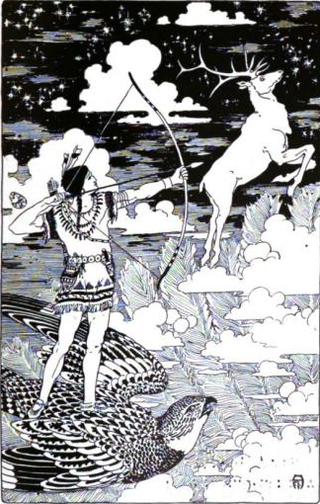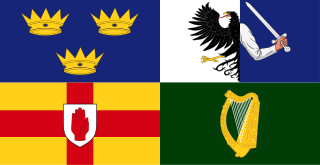Related Research Articles

Alectryon in Greek mythology, was a young soldier who was assigned by Ares, the god of war, to guard the outside of his bedroom door while the god took part in a love affair with the love goddess Aphrodite. Alectryon however failed at his job when he fell asleep, allowing Helios, the god of the Sun, to see the two lovers and alert Hephaestus, the husband of Aphrodite, thereupon Ares changed him into a rooster in anger, in an etiological myth that attempts to explain the origin of roosters and the reason why they crow each morning at dawn, warning of the Sun approaching. The myth is not mentioned by Homer, who first related the story of Ares and Aphrodite's infidelity in his Odyssey, but rather it was interpolated later by various authors.

Mythology of the Haudenosaunee includes the creation stories and folktales of the Native Americans who formed the confederacy of the Five Nations, later the Six Nations. Historically, these stories were recorded in wampum and recited, only being written down later. In the written versions, the spellings of names differ due to transliteration and spelling variations in European languages that were not yet standardized. Variants of the stories exist, reflecting different localities and times.
Pawnee mythology is the body of oral history, cosmology, and myths of the Pawnee people concerning their gods and heroes. The Pawnee are a federally recognized tribe of Native Americans, originally located on the Great Plains along tributaries of the Missouri and Platte Rivers in Nebraska and Kansas and currently located in Oklahoma. They traditionally speak Pawnee, a Caddoan language. The Pawnees lived in villages of earth lodges. They grew corn and went on long bison hunts on the open plains twice a year. The tribe has four bands: the Skidi and "the South Bands" consisted of the Chawi, the Kitkahahki and the Pitahawirata Pawnee.
Seneca mythology refers to the mythology of the Onödowáʼga:, one of the six nations of the Haudenosaunee from the northeastern United States and Canada.

The Indigenous peoples of the Americas comprise numerous different cultures. Each has its own mythologies, many of which share certain themes across cultural boundaries. In North American mythologies, common themes include a close relation to nature and animals as well as belief in a Great Spirit that is conceived of in various ways.

In mythology, folklore and speculative fiction, shape-shifting is the ability to physically transform oneself through unnatural means. The idea of shape-shifting is in the oldest forms of totemism and shamanism, as well as the oldest existent literature and epic poems such as the Epic of Gilgamesh and the Iliad. The concept remains a common literary device in modern fantasy, children's literature and popular culture.

Zorya is a figure in Slavic folklore, a feminine personification of dawn, possibly goddess. Depending on tradition, she may appear as a singular entity, often called "The Red Maiden", or two or three sisters at once. Although Zorya is etymologically unrelated to the Proto-Indo-European goddess of the dawn *H₂éwsōs, she shares most of her characteristics. She is often depicted as the sister of the Sun, the Moon, and Zvezda, the Morning Star with which she is sometimes identified. She lives in the Palace of the Sun, opens the gate for him in the morning so that he can set off on a journey through the sky, guards his white horses, she is also described as a virgin. In the Eastern Slavic tradition of zagovory she represents the supreme power that a practitioner appeals to.

The Iroquois mythic hero Sosondowah was a great hunter known for stalking a supernatural elk, Oh-je-a-neh-doh. Sosondowah was captured by Dawn, a goddess who needed him as a watchman. He fell in love with Gendenwitha, a human woman. He tried to woo her by singing to her in spring as a bluebird, in summer as a blackbird and in autumn as a hawk, who then tried to take Gendenwitha with him to the sky. Dawn tied him to her doorpost and then changed Gendenwitha into the Morning Star, so he could watch her all night but never be with her.
Aušrinė is a feminine deity of the morning star (Venus) in the Lithuanian mythology. She is the antipode to "Vakarinė", the evening star.

The swan maiden is a mythical creature who shapeshifts from human form to swan form. The key to the transformation is usually a swan skin, or a garment with swan feathers attached. In folktales of this type, the male character spies the maiden, typically by some body of water, then snatches away the feather garment, which prevents her from flying away, forcing her to become his wife.

The leannán sídhe is a figure from Irish Folklore. She is depicted as a beautiful woman of the Aos Sí who takes a human lover. Lovers of the leannán sídhe are said to live brief, though highly inspired, lives. The name comes from the Gaelic words for a sweetheart, lover, or concubine and the term for inhabitants of fairy mounds (fairy). While the leannán sídhe is most often depicted as a female fairy, there is at least one reference to a male leannán sídhe troubling a mortal woman.

The Four Indian Kings or Four Kings of the New World were three Mohawk chiefs from one of the Five Nations of the Iroquois Confederacy and a Mohican of the Algonquian peoples, whose portraits were painted by Jan Verelst in London to commemorate their travel from New York in 1710 to meet the Queen Anne of Great Britain. The three Mohawk were: Sa Ga Yeath Qua Pieth Tow of the Bear Clan, called King of Maquas, with the Christian name Peter Brant ; Ho Nee Yeath Taw No Row of the Wolf Clan, called King of Canajoharie, or John of Canajoharie; and Tee Yee Ho Ga Row, meaning "Double Life", of the Wolf Clan, also called Hendrick Tejonihokarawa or King Hendrick. The Mohican chief was Etow Oh Koam of the Turtle Clan, mistakenly identified in his portrait as Emperor of the Six Nations. The Algonquian-speaking Mohican people were not part of the Iroquois Confederacy. Five chiefs set out on the journey, but one died in mid-Atlantic.
Hartley Burr Alexander, PhD (1873–1939), was an American philosopher, writer, educator, scholar, poet, and iconographer.

The loathly lady, is a tale type commonly used in medieval literature, most famously in Geoffrey Chaucer's The Wife of Bath's Tale. The motif is that of a woman who appears unattractive but undergoes a transformation upon being approached by a man in spite of her unattractiveness, becoming extremely desirable. It is then revealed that her ugliness was the result of a curse which was broken by the hero's action.
Ida Julia Pollock was a British writer of several short-stories and over 125 romance novels that were published under her married name, Ida Pollock, and under a number of different pseudonyms: Joan M. Allen; Susan Barrie, Pamela Kent, Averil Ives, Anita Charles, Barbara Rowan, Jane Beaufort, Rose Burghley, Mary Whistler and Marguerite Bell. She has sold millions of copies over her 90-year career. She has been referred to as the "world's oldest novelist" who was still active at 105 and continued writing until her death. On the occasion of her 105th birthday, Pollock was appointed honorary vice-president of the Romantic Novelists' Association, having been one of its founding members.

High visibility of the star cluster Pleiades in the night sky and its position along the ecliptic has given it importance in many cultures, ancient and modern. Its heliacal rising, which moves through the seasons over millennia was nonetheless a date of folklore or ritual for various ancestral groups, so too its yearly heliacal setting.
Queen Esther (EH-stur) of Pennsylvania was a Native American woman belonging to the Iroquois in the mid-1700s. Her village consisted of over five hundred citizens and was located between the towns of Sayre, Pennsylvania, Athens, Pennsylvania and Waverly, New York.
References
- ↑ Alexander, Hartley Burr (2003). North American Mythology. Kessinger Publishing. p. 26.
- ↑ Olcott, Frances Jenkins; Richardson, Frederick (1917). "The Red Indian Fairy Book for the Children's Own Reading and for Story-tellers" (Document). Houghton Mifflin Company.
- ↑ Alexander, Hartley Burr (2003). North American Mythology. Kessinger Publishing. p. 26.